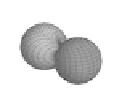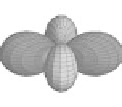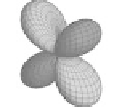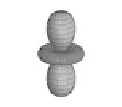Graphics Reference
In-Depth Information
Figure 10.1
Spherical harmonic (SH) basis functions. (Courtesy of Peter-Pike Sloan.)
cally, spherical harmonics are a collection of orthogonal functions defined on the
unit sphere. To review, the real SH basis functions are defined as (from Equa-
tion (7.2.4))
⎧
⎨
√
2
K
l
P
l
cos
(
m
φ
)
(
cos
θ
)
,
m
>
0
√
2
K
l
sin
P
−
m
l
Y
l
,
m
=
(
−
m
φ
)
(
cos
θ
)
,
m
<
0
⎩
K
l
P
l
(
cos
θ
)
,
m
=
0
l
;
K
k
is a normalizing factor, and
P
l
are the associated Legendre polynomials described in Chapter 7. The first few
real SH basis functions are listed in Table 7.1, and illustrated in Figure 10.1. The
SH basis functions
Y
l
,
m
depend on two variables,
for each
l
=
0
,
1
,
2
,...
and
m
=
−
l
,...,
θ
and
φ
, which are the usual
is the
angle in the
xy
-plane (the
longitude
or
azimuth
). The index
l
is the
degree
of
the basis function. A particular basis function has at most
l
oscillations in
spherical coordinates:
θ
is the angle of the
z
-axis (the colatitude) and
φ
θ
and
φ
,so
l
also provides the angular frequency of the basis function. When
m
=
0,
the SH basis function
Y
l
,
0
depends only on
.
The spherical-harmonic expansion of a given spherical function
L
θ
(
θ
,
φ
)
is a
sum of the form
n
1
l
=
0
−
l
m
=
−
l
L
l
Y
l
,
m
(
θ
,
φ
)
,
L
(
θ
,
φ
)=
(10.1)



















